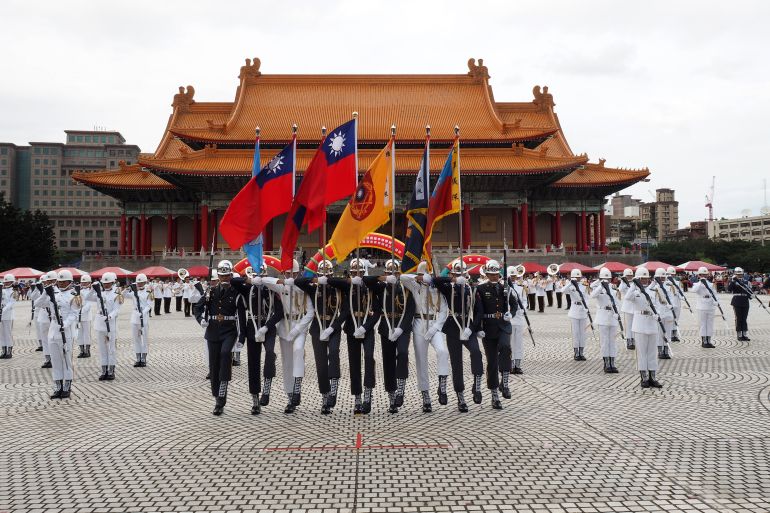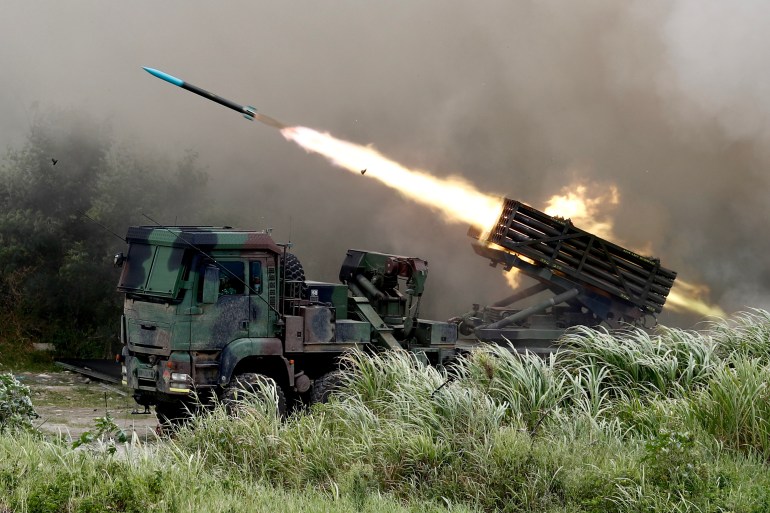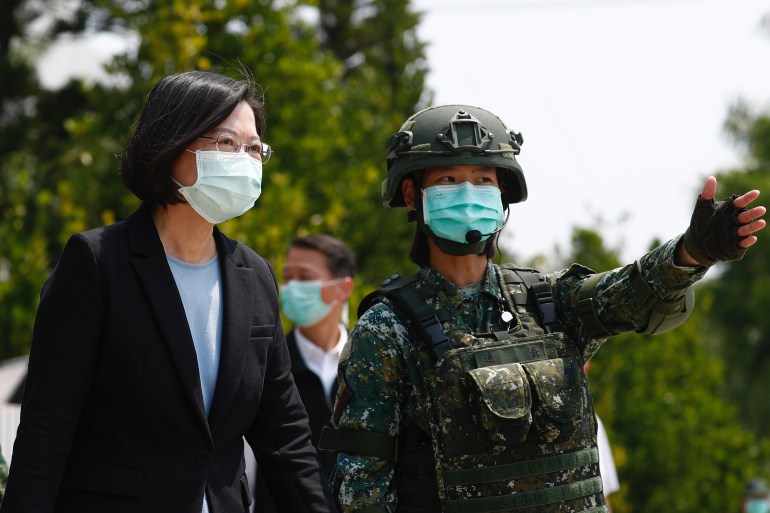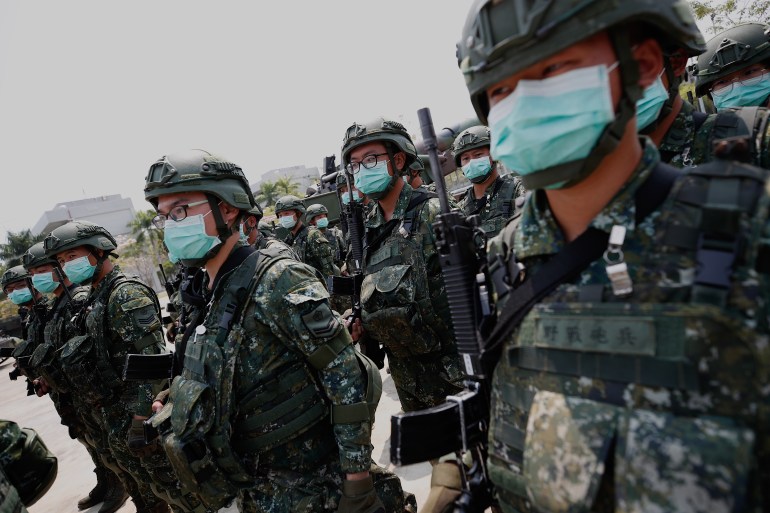Martial-law era casts long shadow over Taiwan’s military
Island is overhauling conscription as it tries to boost armed forces to face an increasingly assertive China.

Taipei, Taiwan – At Jing-Mei White Terror Memorial Park, a one-time military school-turned-detention centre, visitors can walk around the buildings where some of Taiwan’s most prominent political prisoners were held, interrogated and tried during 38 years of martial law.
The museum takes visitors through detention facilities, a replica court and exhibits featuring testimony from former inmates to give visitors a sense of life during the period, now known as the White Terror.
Keep reading
list of 4 items‘A cudgel against Beijing’: US ambassador to UN to visit Taiwan
‘Cheap trick’: China rebuffs Taiwan’s latest offer for talks
China aircraft carrier sails through Taiwan Strait raising alarm
Many of the political prisoners were arrested by the military police and the Taiwan Garrison Command, known as the “the most nefarious part of the military,” said Bill Sharp, a visiting scholar in National Taiwan University’s history department.
“It was the Taiwan Gestapo and if you fell afoul of the government, you’d get a knock on your door in the wee hours and: ‘You need to come with us’.”
The Taiwan Garrison Command was formally disbanded in 1992, shortly before Taiwan’s transition to democracy but its legacy has left an indelible impression on the public of what can happen when the armed forces are allowed unchecked power and for years has hindered attempts to develop a modern military.
“The image of the military in Taiwan is very poor and most people distrust the military [because] of the era of White Terror when the military was the pillar of totalitarianism, dictatorship and it consumed vast amounts of money,” Sharp said.
Where it once stationed thousands of troops on offshore islands like Kinmen, just six kilometres (3.73 miles) from China and in vast numbers along the coast, for most of the past few decades the military has struggled to find enough people to fill its ranks.

Ironically, it was only with the 2016 election of Tsai Ing-wen as president – whose party was founded in the 1980s in part to challenge martial law – that the situation began to change.
Tsai has made military modernisation a key policy, regularly visiting troops to raise morale, making extensive weapons purchases and supporting the increase in military spending to a record-high $15.2bn to fortify Taiwanese against their historic rival: the People’s Republic of China.
‘Every street a shooting gallery’
The government has further enhanced public appreciation for the military by disclosing Chinese military manoeuvres near Taiwanese territory, which appear to have escalated over the past year to near-daily encounters after Chinese President Xi Jinping pledged to “retake” Taiwan by force if necessary.
Now one year into her second term, Tsai is attempting something that could be more politically risky given her party’s support base among the under-40s – enhancing the island’s military reserves.
Any changes are likely to ask more of young Taiwanese, particularly its men, who are already required to serve four months of military conscription in addition to regular review courses until the age of 35.
While Taiwan’s reserves number nearly 1.7 million, according to the Global Firepower Index, those on active duty number between 150,000 and 165,000 depending on estimates. Many experts wonder if the island’s armed forces are even strong enough to meet the growing threat from the People’s Liberation Army (PLA) – and its more than two million active personnel – just across the sea.
“When you’re facing a challenge like you face in the PLA, four months is not going to cut it,” said Michael Mazza, a visiting fellow in foreign and defence policy studies at the American Enterprise Institute. “What’s more problematic beyond those four months is how minimal the training is afterwards: a week or less every year for eight years. In theory, you have this large reserve force that has received very little training,”
Since the 1990s, the PLA has made dramatic strides forward in its attempt to become a “world-class force,” capable of not only dominating the disputed South China Sea but also invading Taiwan, over which Beijing’s Communist Party claims sovereignty.
In a Department of Defense report released last September, the US concluded that the PLA was preparing for a scenario where it might attempt to “unify Taiwan with the mainland by force,” and push back any attempt at “third-party intervention” in the form of the US military coming to the island’s defence.

“Taiwan has traditionally made up for a quantitative disadvantage relative to the PLA with a significant qualitative advantage over their adversaries – better equipment, training, doctrine, and so forth. But now, in most areas that qualitative advantage is gone and given China’s long-term military modernisation plan, it’s not coming back,” said Kharis Templeman, an adviser to the Project on Taiwan in the Indo-Pacific at Stanford University’s Hoover Institution. “Taiwan simply can’t take on the PLA directly in a peer-to-peer fight if Beijing commits its full force to the fight.”
Facing such a powerful opponent, Taiwan has begun to shift its defence policy to an “asymmetric” one, developing the kind of mobile units and weaponry that would prevent an invasion force from ever landing. The government has recently started purchasing new weapons like rocket launchers, drones and cruise missiles and building its first domestically produced submarines, but boosting the reserves would also play a crucial role, Mazza said.
“In a war-time scenario, the reserves become incredibly important in particular in the event the PLA secures a beachhead. The reserve force has the potential to serve as a really potent deterrent to Chinese invasion because it can be trained and armed essentially to fight for every square inch of land between the beaches and the major cities, to turn every city street into a shooting gallery,” he said. “The question is if that’s something the Taiwan reserve force can do and people reasonably have their doubts about that.”
‘Waste of time’
Mindful of the weaknesses, military planners have already embarked on significant organisational changes, said Liao “Kitsch” Yen-Fan, a security analyst at the Institute of National Defense and Security Research in Taiwan.
In October, Taiwan’s Ministry of Defense announced it was setting up the Defense and Reserve Mobilization Administration, a new unified agency to oversee the reserves.
The ministry is also reorganising training programmes for recruits – dividing them into coastal defence, critical installations and urban and rear defence, with conscripts focusing on urban areas, Liao said. Since 2017 it has begun to call up its recent professional retirees in their 30s and 40s for refresher courses, he said, while conscripts have also reported qualitative improvements in their annual call-up.
“A lot of people who got called up recently were saying their recent experience greatly differed from previous instances and it’s a much more intense experience,” Liao said. “For example, the restriction on how much ammunition is available for each training session’s gone. Now it’s as much as you need and on top of that, they were required to familiarise themselves more with basic skills and lower-level tactics in the field. This is all much to the good, even though it may not necessarily translate into actual combat power.”

The hardest sell, however, may be a proposal from the defence ministry to extend conscript review courses in 2022 from around seven days every other year to 14 days every year, although salaries will also go up across the board. It will also seek to learn from others – a delegation is expected to travel to Israel this year to study the way its reserves are organised and the country’s rapid mobilisation system.
Experts, however, say more is needed, from more financing to reorganising how reserves are called up – making the switch to calling up units of reserves as opposed to individuals to improve morale and group cohesion.
One change many experts agree is necessary, but unlikely, is Taiwan fulfilling its pledge to become an all-volunteer military.
While many are wary about signing up as a result of the historical legacy of martial law, the island faces a more intractable problem – its population is shrinking.
The government has turned to women to fill the gap, although Taiwan still lags behind countries such as Singapore and Israel, according to a review of its military by the RAND Corporation. Conscription for women has also been floated in public opinion polls.
For now, patriotism remains the biggest driving force for recruitment.
“If there’s a serious military crisis, that might raise the popularity of the Taiwan armed forces in a hurry. Already, the air force is getting a lot of positive press these days because of its frequent sorties to intercept Chinese military planes,” said Templeman.
“But most important is making basic training more systematic and relevant to actual war-fighting. Conscription is very unpopular because most people who’ve gone through it see it as a total waste of time: many trainees don’t even learn how to fire a gun. If, in the process of trying to create functional unit-level reserves, basic training is revamped and intensified, that might help, paradoxically,” he said.